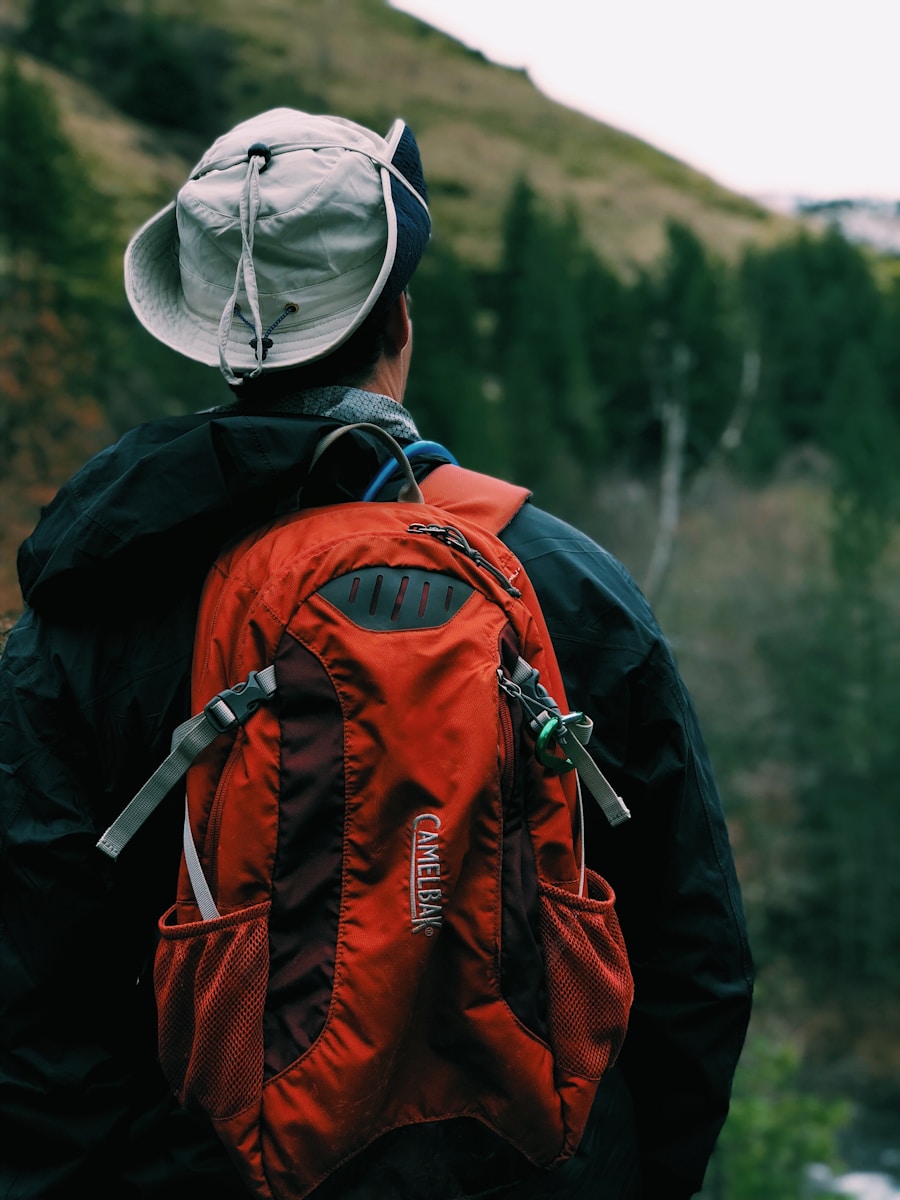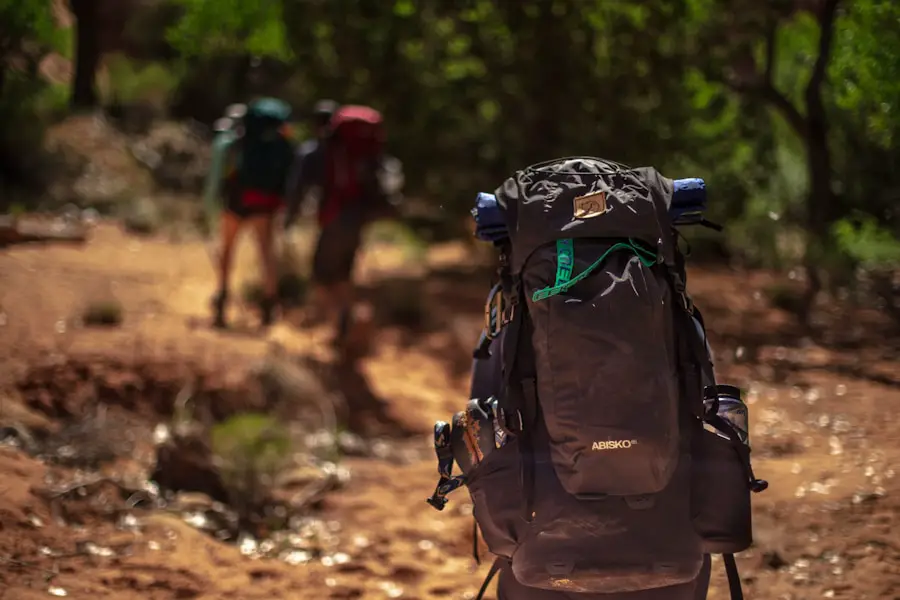Hiking gear encompasses a wide array of equipment and clothing designed to enhance the outdoor experience while ensuring safety and comfort. At its core, hiking gear includes items that protect the hiker from environmental elements, provide necessary support, and facilitate navigation through various terrains. This can range from footwear and clothing to backpacks and navigation tools.
The right gear not only contributes to a more enjoyable hiking experience but also plays a crucial role in preventing injuries and ensuring that hikers are prepared for unexpected challenges. The importance of selecting appropriate hiking gear cannot be overstated. For instance, the choice of footwear can significantly impact a hiker’s performance and comfort level.
Hiking boots or shoes are designed with specific features such as traction, support, and waterproofing to cater to different trail conditions. Similarly, clothing made from moisture-wicking and breathable materials can help regulate body temperature and manage sweat, which is essential for maintaining comfort during long hikes. Understanding the basics of hiking gear is the first step toward making informed decisions that align with individual needs and preferences.
Key Takeaways
- Hiking gear includes essential items such as backpacks, footwear, clothing, navigation tools, and safety equipment.
- Must-have gear for every hiker includes a sturdy backpack, comfortable and supportive footwear, weather-appropriate clothing, navigation tools, and safety essentials.
- Finding the balance between quality and cost is important when investing in hiking gear to ensure durability and performance without breaking the bank.
- Hikers can save on gear by opting for budget-friendly options for items like clothing, accessories, and some equipment, without compromising on quality.
- Investing in specialty gear such as trekking poles, hydration systems, and specialized footwear can enhance the hiking experience and provide long-term benefits.
The Essential Gear: Must-Haves for Every Hiker
When embarking on a hiking adventure, certain essential items are non-negotiable for ensuring safety and comfort. A sturdy pair of hiking boots or shoes is paramount; they provide the necessary grip and support for uneven terrain. Footwear should be chosen based on the type of hiking planned—whether it’s a day hike on well-maintained trails or a multi-day trek through rugged landscapes.
Additionally, investing in moisture-wicking socks can prevent blisters and keep feet dry, enhancing overall comfort. Another critical component of hiking gear is the backpack. A well-fitted backpack allows hikers to carry essential supplies without straining their bodies.
The size of the backpack should correspond to the length of the hike; day packs are typically sufficient for short excursions, while larger packs are necessary for overnight trips. Inside the backpack, hikers should carry a first-aid kit, water purification system, snacks, and navigation tools such as maps or GPS devices. These items not only ensure preparedness but also contribute to a more enjoyable hiking experience by allowing hikers to focus on the journey rather than worrying about potential mishaps.
When it comes to purchasing hiking gear, one of the most significant considerations is the balance between quality and cost. High-quality gear often comes with a higher price tag, but it can also provide better performance, durability, and safety features. For example, a well-constructed pair of hiking boots may cost more upfront but can last for years if properly maintained, whereas cheaper alternatives may wear out quickly or fail to provide adequate support, leading to discomfort or injury.
However, it is essential to recognize that not all expensive gear guarantees superior performance. Some brands may charge a premium for their name rather than the quality of their products. Therefore, it is crucial for hikers to conduct thorough research before making purchases.
Reading reviews, seeking recommendations from experienced hikers, and testing gear in-store can help individuals make informed decisions that align with their budget while still ensuring they acquire reliable equipment.
Budget-Friendly Options: Where to Save on Hiking Gear

For those who are budget-conscious yet eager to explore the great outdoors, there are several strategies to save on hiking gear without compromising safety or comfort. One effective approach is to consider purchasing used or refurbished equipment. Many outdoor retailers offer second-hand gear in good condition at significantly reduced prices.
Websites dedicated to outdoor gear exchanges also provide platforms where hikers can buy or trade equipment, allowing them to acquire quality items at lower costs. Another way to save money is by taking advantage of seasonal sales and discounts offered by outdoor retailers. Many companies have clearance events at the end of hiking seasons or during holidays, providing opportunities to purchase high-quality gear at reduced prices.
Additionally, opting for multi-functional items can also lead to savings; for instance, a jacket that serves as both an outer layer and an insulating layer can reduce the need for multiple pieces of clothing. By being strategic about purchases and exploring various options, hikers can build a solid collection of gear without breaking the bank.
Specialty Gear: When to Invest in Specific Items
| Item | Investment Criteria | Example |
|---|---|---|
| Climbing Gear | Invest in high-quality gear if you frequently climb in challenging outdoor environments | High-quality ropes, harnesses, and carabiners for mountaineering expeditions |
| Scuba Diving Equipment | Invest in specific items if you plan to dive in cold water or deep sea environments | Drysuits, dive computers, and specialized regulators for technical diving |
| Backpacking Gear | Invest in lightweight and durable gear for long-distance treks or thru-hikes | Ultralight tents, sleeping bags, and backpacks for multi-day wilderness trips |
| Skiing and Snowboarding Equipment | Invest in specific items for advanced performance and safety in challenging terrain | High-performance skis or snowboards, avalanche safety gear, and backcountry touring equipment |
While many hiking essentials are universal, certain situations may warrant investment in specialty gear tailored to specific activities or environments.
For example, if a hiker plans to tackle challenging terrains such as snow-covered mountains or rocky paths, investing in specialized footwear like crampons or mountaineering boots becomes crucial. These items are designed to provide enhanced traction and support in extreme conditions, ensuring safety during treks that would otherwise be perilous.Similarly, if a hiker frequently ventures into colder climates or engages in winter sports like snowshoeing or backcountry skiing, high-quality insulated jackets and thermal layers become essential investments. These specialized garments are engineered with advanced materials that trap heat while allowing moisture to escape, keeping the hiker warm and dry in frigid temperatures. While these items may come with a higher price tag, their performance in specific conditions justifies the investment for those who regularly engage in such activities.
Hidden Costs: Maintenance and Upkeep of Hiking Gear
Beyond the initial purchase price of hiking gear lies an often-overlooked aspect: maintenance and upkeep costs. Proper care of equipment is essential for prolonging its lifespan and ensuring optimal performance. For instance, hiking boots require regular cleaning and conditioning to maintain their waterproofing and structural integrity.
Neglecting this maintenance can lead to premature wear and tear, resulting in costly replacements sooner than expected. Additionally, other gear such as tents and sleeping bags also necessitates specific care routines. Tents should be cleaned after each use and stored properly to prevent mold growth and damage from UV exposure.
Sleeping bags require regular washing according to manufacturer instructions to maintain insulation properties. These maintenance tasks may seem minor but can accumulate over time, impacting the overall cost of ownership for hiking gear.
The Price of Comfort: Upgrading Your Hiking Experience

Investing in higher-quality hiking gear often translates into enhanced comfort during outdoor adventures. For instance, upgrading from standard cotton clothing to moisture-wicking fabrics can significantly improve a hiker’s experience by regulating body temperature and reducing chafing during long treks. Similarly, high-performance backpacks with ergonomic designs distribute weight more evenly across the body, reducing fatigue and allowing hikers to cover greater distances comfortably.
Moreover, specialized gear such as trekking poles can also enhance stability and reduce strain on joints during descents or uneven terrain navigation. While these items may represent an additional expense upfront, their contribution to overall comfort and safety makes them worthwhile investments for avid hikers. The cumulative effect of these upgrades can transform a challenging hike into an enjoyable experience, encouraging individuals to explore new trails and push their limits.
The Overall Investment of Hiking Gear
The investment in hiking gear extends beyond mere financial considerations; it encompasses safety, comfort, and the overall enjoyment of outdoor experiences. While it is possible to find budget-friendly options that meet basic needs, understanding when to invest in higher-quality or specialized items is crucial for those who wish to engage in more demanding hikes or frequent outdoor activities. By balancing quality with cost-effectiveness and considering maintenance needs, hikers can make informed decisions that enhance their adventures while ensuring they are well-prepared for whatever nature may present.
Ultimately, the right hiking gear serves as an enabler of exploration—allowing individuals to connect with nature while minimizing risks associated with outdoor activities. As such, investing in quality equipment is not merely about spending money; it is about fostering a deeper appreciation for the great outdoors and empowering oneself to embark on new adventures with confidence.
If you are considering hiking as a travel activity, you may be wondering how much hiking gear costs. The cost of hiking gear can vary depending on the quality and brand of the items you choose. To help you plan your hiking trip budget, you can check out this article on the best time to travel to Spain. This guide will provide you with information on the ideal seasons to visit Spain, allowing you to plan your hiking adventure accordingly.
FAQs
What is the average cost of hiking gear?
The average cost of hiking gear can vary depending on the quality and brand of the items. However, a basic set of hiking gear can cost anywhere from $200 to $500.
What are some essential hiking gear items and their average costs?
Some essential hiking gear items include hiking boots ($80-$200), a backpack ($50-$300), a tent ($100-$400), a sleeping bag ($50-$300), and a water filtration system ($20-$100).
Are there any ways to save money on hiking gear?
Yes, there are several ways to save money on hiking gear. You can look for sales and discounts at outdoor retailers, buy used gear from online marketplaces, or borrow gear from friends or family.
What are some higher-end hiking gear items and their average costs?
Some higher-end hiking gear items include ultralight backpacks ($200-$500), high-performance hiking boots ($200-$500), and technical outerwear ($150-$500).
Are there any additional costs associated with hiking gear?
In addition to the cost of the gear itself, hikers may also need to budget for other expenses such as permits for certain trails, camping fees, and transportation to and from hiking destinations.
